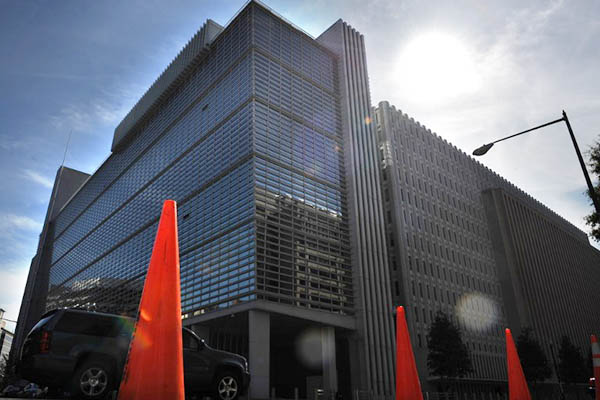
File photo of World Bank headquarters in Washington, D.C. Tim Sloan—AFP
The World Bank on Tuesday issued its latest Global Economic Prospects report, amending its growth forecast for Pakistan in the ongoing fiscal year to 2 percent, down from the 4 percent projected in June 2022.
According to the report, the “precarious economic situation” in Pakistan has worsened due to last year’s floods. Noting that the country was already struggling with low foreign exchange reserves and large fiscal and current account deficits, it said the floods had impacted a third of the country, with recovery and reconstruction needs expected to be 1.6 times the national development budget for fiscal year 2022-23. “The flooding is likely to have seriously damaged agricultural production—which accounts for 23 percent of GDP and 37 percent of employment—by disrupting the current and upcoming planting seasons and pushed between 5.8 and 9 million people into poverty,” it said, adding that policy uncertainty was further complicating the economic outlook.
The Washington-based lender said Pakistan’s economic output was not only declining internally, but was also bringing down the regional growth rate. Even next year, it predicted, Pakistan’s GDP growth rate would only improve to 3.2 percent, 1 percent lower than last year’s estimate of 4.2 percent.
On the country’s low foreign exchange reserves and rising sovereign risk, the World Bank said the Pakistani rupee had been depreciated by 14 percent between June and December, while its country risk premium rose by 15 percent in the same period. Similarly, it said, Pakistan’s consumer price inflation had hit 24.5 percent. This had led to a dramatic increase in food prices, it said, noting this was not restricted to Pakistan in the South Asian region, and was boosting food insecurity.
By contrast, read the report, export bans on food—such as those undertaken by Afghanistan, Bangladesh, India, Pakistan—also risked exacerbating increases in global food prices. Overall, it said, South Asia was anticipated to grow by 5.5 percent and 5.8 percent in 2023 and 2024, respectively, primarily due to estimated 6.6 percent and 6.1 percent GDP growth in India. “This pace reflects still robust growth in India, Maldives, and Nepal, offsetting the effects of the floods in Pakistan and the economic and political crises in Afghanistan and Sri Lanka. The deteriorating global environment, however, will weigh on investment in the region,” it warned.
Global outlook
The World Bank warned of a global slowdown, noting that growth was expected to decelerate sharply to 1.7 percent in 2023—the third weakest pace in nearly three decades. “This is 1.3 percentage points below previous forecasts,” it said, citing policy tightening aimed at curtailing high inflation, worsening financial conditions, and continued disruptions from Russia’s invasion of Ukraine.
The combination of slow growth, tightening financial conditions, and heavy indebtedness was likely to weaken investment and trigger corporate defaults, it stressed, warning that any additional negative shocks could push the global economy into recession. To avoid this, it said, national policies should ensure fiscal support is provided to vulnerable groups, inflation expectations remain well-anchored, and financial systems continue to be resilient.
